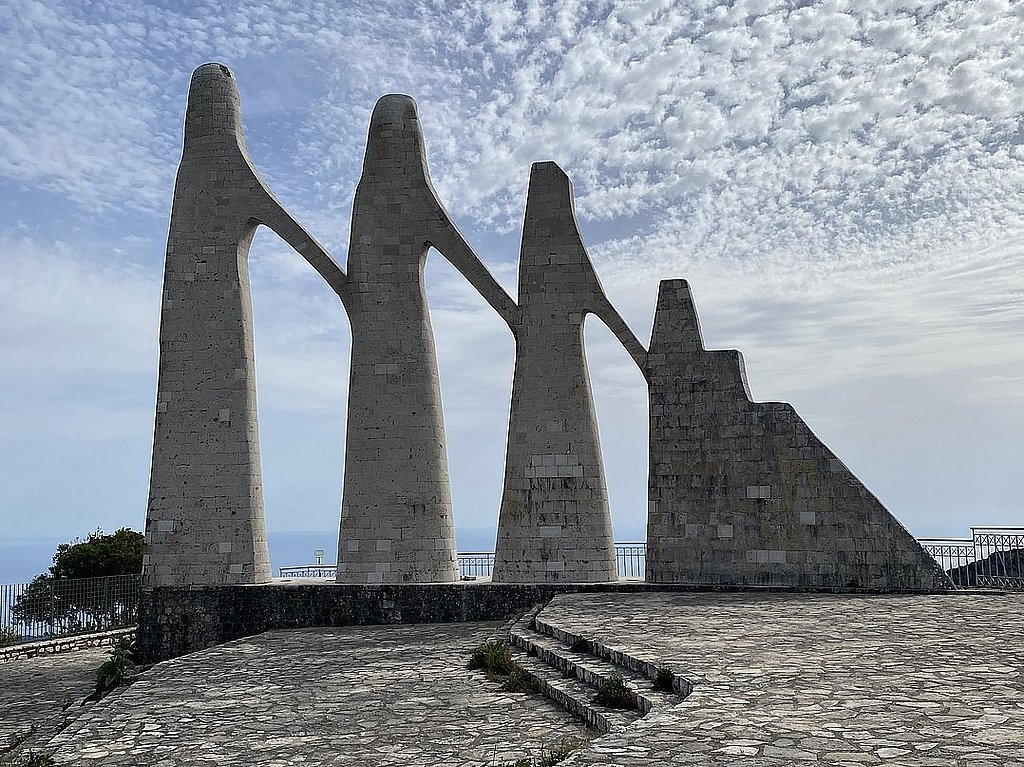The students (social work) Philipp and Golnar of the project module "Remembrance work and transgenerational heritage using the example of German-Greek history" report in a travel diary about their seminar trip to Greece.
Day 1: Arrival in Ioannina
Our study trip began with our arrival in Ioannina, where we were to spend the next few days as part of the university seminar "Political education: memory work and transgenerational heritage using the example of German-Greek history", led by Prof. Dr. Jutta Hartmann and Amar Bašić. Together with 15 students and the two lecturers from Alice Salomon University of Applied Sciences Berlin, we traveled to Greece as part of an ERASMUS cooperation agreement with the University of Ioannina to deal with German occupation history, Jewish life and remembrance work on site. With a feeling of excitement and anticipation, we students arrived in Ioannina in the evening and took in the beautiful city.
Day 2: Art as a mediator
In the morning, we visited the University of Ioannina, where we listened to two impressive lectures: one was dedicated to the German occupation of Greece (1941-1944) and its reappraisal by Prof. Dr. Athanasios Gotovos, the other to the history and Jewish life in Ioannina by Andreas Gotovos.
Thanks to the in-depth knowledge of the two lecturers, we were able to gain a comprehensive insight into our seminar topic and ask the two experts specific questions.
In the afternoon, we took part in a historical city tour led by the artist Adi Liraz and the publisher Panos Vardaloukas. Adi Liraz, herself a descendant of the Jewish community, accompanied us through important places in the city, including the synagogue and the Jewish quarter. Her personal contribution to the culture of remembrance was particularly impressive: through her artistic work, she manages to make biographical remembrance an emotional and interactive experience - an approach that touched us deeply.
Day 3: Collective remembrance
The morning was dedicated to exchanging ideas with Greek students from the University of Ioannina. We presented our seminars to each other and got talking about collective memory, national narratives and shared responsibility. In this way, we built up a mutual understanding and gained an insight into how studying in Greece works.
We students from Germany found the grounds of the University of Ioannina very exciting. The buildings, most of which were built in a brutalist style, were covered in graffiti and anti-fascist slogans.
In the afternoon, we made our way to the martyrs' village of Paramythia. Two consecutive executions of civilians by the German Wehrmacht took place there within ten days in September 1943 - with the active participation of local collaborators. On site, we met the mayor, the mayor for culture and education of the city and the president of the local council. We visited the memorial to the 49 victims and laid a wreath there together - a moment of silent sympathy and deep reflection.
We then took a bus to the Zalongo memorial, which commemorates the sixty women and children who, according to legend, chose suicide rather than live under Ottoman occupation. We had already learned about various memorial formats in our seminar, but we were still very impressed by the Zalongo Memorial. It is enthroned high up on a hill, from where you have a sweeping view over the landscape. The monumental size of the memorial was also impressive and left a lasting impression.
We reached the village of Kommeno in the early evening. The warm welcome from the villagers was moving and showed how open and hospitable the community is.
Day 4: Remembrance work in Kommeno
The fourth day was dedicated entirely to remembrance formats in Kommeno. We visited the memorial on the village square, the memorial installation at the entrance to the village of Amar Bašić and the "Friends of Kommeno" education center. The audio walk "Voices of Kommeno" by Lefteris Krysalis and Amar Bašić was particularly moving, as it featured descendants of the victims and brought the history of the place to life in an impressive way.
Many of us commented that it was only through direct experience in the village that a deeper understanding of the topic of remembrance work in Kommeno emerged. Afterwards, we spoke with Dimitra Vlachou, Giorgos Fakos and Panagiotis Giotis, three members of the cultural association, who described their personal connections to the history of the massacre and their work in the village.
The meeting with Dimitra Vlachou, who surprised us with homemade cake, was particularly warm.
In the evening, the head of the village, Ilias Lampris, showed us a film he had put together himself with historical footage and testimonies - a moving end to this intense day. Regular reflection sessions in the guest house, where we slept during our stay, enabled us to process and share our impressions. The guest house not only served as a place for reflection, but also as a meeting place.
Day 5: Reflection by the sea
On the last day, we took a trip to Kopraina on the Ambracian Gulf to bring the trip to a close. The relaxing day by the sea offered the opportunity to reflect on what we had experienced and to process it in joint discussions. The tranquillity and nature helped to sort out the intense impressions of the previous days.
Our seminar trip to Ioannina and Kommeno was an educational, emotional and stirring experience. The encounters with contemporary witnesses, descendants and committed local people, combined with the openness and warmth of our Greek hosts, gave us deep, personal access to Greece's past and present. The diverse trip not only enriched us in terms of content, but also moved us emotionally thanks to the personal encounters. It will certainly have a lasting effect.



